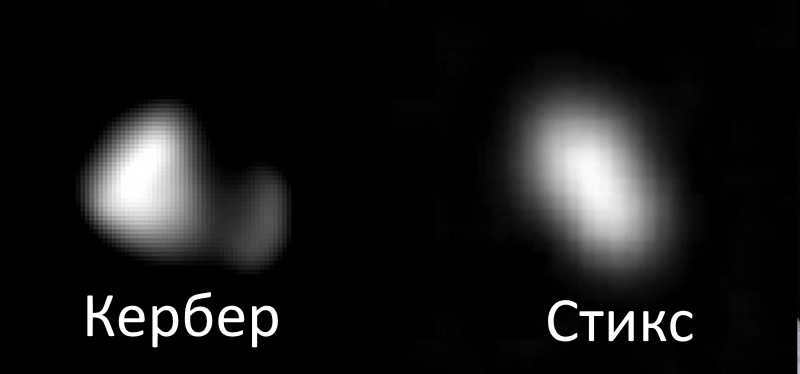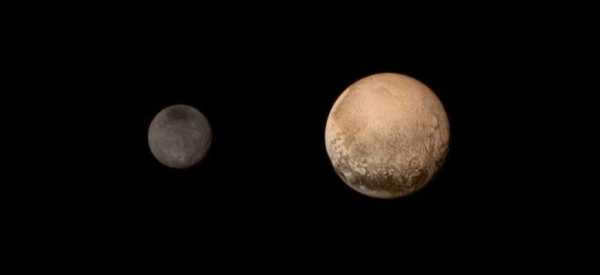

Pluto, a celestial body in our solar system, was first spotted in 1930 by Clyde Tombaugh, an American astronomer. Since then, scientists have been able to identify several satellites orbiting around Pluto, which will be the main focus of this article.
Characteristics of the celestial body
Pluto possesses the attributes of a stellar type with a magnitude of 15. This implies that it is 15 times smaller than the stars that can be seen with the naked eye. The rotational speed of this extraterrestrial entity is exceedingly sluggish.
It takes 247.7 years for one complete orbit around its star. Although this celestial object can approach the Sun more closely than Neptune, it remains quite distant, limiting the possibilities for conducting thorough investigations.
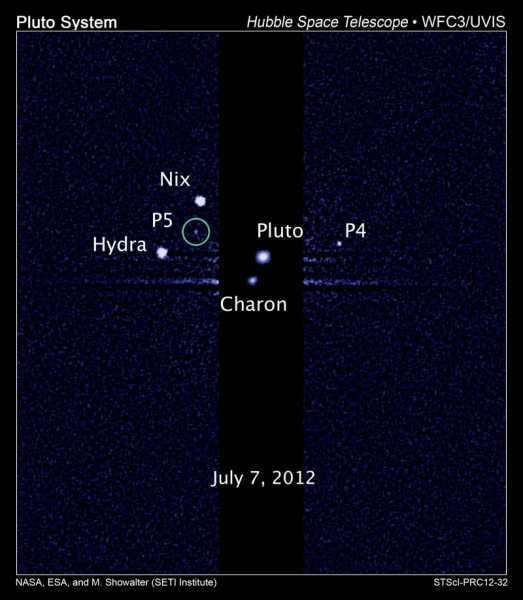
In 2012, the Hubble telescope captured an image of Pluto and its satellites.
Satellite Count and Characteristics
Pluto has a total of 5 satellites. The largest one is called Charon, followed by Styx, Nycta, Kerberus, and Hydra. All of them orbit in a circular path within the plane of Pluto’s equator.
These satellites are all in near resonance, with the ratio of their orbital periods being 1:3:4:5:6. The rotation of Pluto and Charon is synchronous, meaning they always have the same side facing each other. The smaller satellites have much shorter rotation periods.
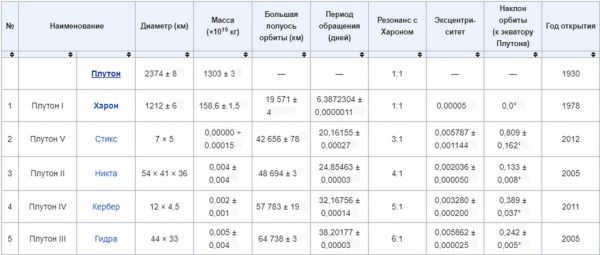
Click on the picture to enlarge
Charon
The finding of this celestial body goes back to the year 1978. It was discovered by J. Christie. It possesses a diameter that measures 1,200 kilometers, which is half the size of the main planet. The determination of the dimensional characteristics of these entities was carried out with the utmost precision. This was made possible by the fact that Charon passed in close proximity to the main object’s disk, allowing the researchers to perform detailed calculations.
As a result of the discovery of Charon, the mass index of Pluto was revised and found to be even smaller than anticipated. The distance between their central parts is 19,600 km, while the distance between their surfaces is 17,800 km.


A visual depiction of the Pluto system. P1 – Hydra, P2 – Nycta
Regarding the center of mass of this system, it exists beyond the surface of the primary planet. As a result, numerous astronomers are convinced of the dual nature of Pluto. Alternatively, it is referred to as a binary asteroid. According to the initial resolution proposed by the IAU (2006), Charon was intended to be recognized as an individual planet. However, the final version led to a different decision, which introduced the concept of a “dwarf planet”. This classification included various celestial bodies such as Pluto, Erid, and Ceres. Charon did not make the cut for this list.
Nycta and Hydra
Pluto has two well-known satellites called Nycta and Hydra. These celestial bodies were initially detected through photographs taken by the Hubble Space Telescope in May 2005. The media reported their discovery in the same year, and on June 21, 2006, they were officially named. Nycta has an orbital radius of 49,000 square kilometers, while Hydra’s radius is 65,000 square kilometers. This means that compared to Charon, they are positioned at a distance twice or three times farther from Pluto.
Hydra measures 43*33 km in size, while Nycta has dimensions of 51*41*36 km. Currently, it is challenging to determine their mass as this information is unknown. Scientists estimate that their mass is approximately 0.003% of the mass of Charon and 0.0003% of Pluto’s size. Both objects exhibit visible craters on their surfaces, and their albedo values differ across different regions. Additionally, Nycta displays variations in color, with a reddish area surrounding a prominent crater.
Styx and Kerber
These two satellites of Pluto, Styx and Kerber, are still under active research. In June 2011, the world of astronomy witnessed another breakthrough when the wide-angle camera on the Hubble telescope discovered the satellite Kerber. The discovery was made possible by the collaboration of three telescopes.
After its discovery, Kerber was found to have a size of 12*4.5 km. A year later, in July 2012, using the same equipment, the fifth satellite, Styx, was also discovered. Initially, it was given the temporary designation of S/2012 but later received its current name. Styx has a size of 7*5 km and orbits at a radius of 42,000 km.
Origin theories
It is quite likely that the moons of Pluto were created as a result of a side-on collision between the planet and another similarly-sized object moving at a low speed. It is possible that Charon formed from the remaining fragments of this object and may not have been significantly damaged. The other moons may have formed from the debris ejected during the collision. Initially, they were in close proximity to the planet and had highly elliptical orbits. Over time, however, due to tidal interactions, Charon assumed its current orbit and its rotational velocity also changed.
Consequently, the moons orbiting around Pluto are accounted for in a total of five entities and, in spite of being relatively researched, are still being examined up to the present day.
Pluto is a minuscule celestial body within the solar system. It was initially detected by Clyde Tombaugh, an American astronomer, in 1930. Furthermore, the satellites of Pluto were subsequently uncovered and scrutinized. The average distance separating the planet from the Sun is slightly less than 40 astronomical units (a.u.). Pluto is a celestial body with fifteen stars.
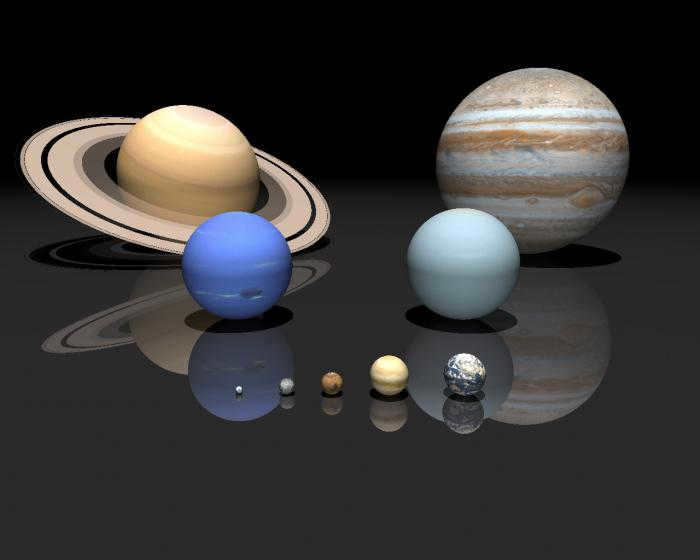
Pluto is an astronomical object with a magnitude of 15 stars. This implies that it appears 4000 times dimmer than the stars visible to the naked eye. The rotation of this celestial body is exceptionally slow, taking 247.7 years to complete one orbit. Although Pluto comes closer to the Sun than Neptune, it remains quite distant, posing significant challenges for scientific investigation.
How the Name “Pluto” was Chosen
The responsibility of naming the newly discovered planet was given to W.M. Slifer, the director of the Lovell Observatory. At first, his wife suggested calling it “Zeus”, then “Lovell”, and later proposed the name “Constance”, but none of these choices were accepted. Typically, planets were named after Roman gods, and “Pluto” seemed to be the most fitting name for this new discovery. Additionally, it conveniently shared the same initials as the observatory director.

There were actually many more suggestions for the name of the new planet. For instance, the editors of the widely-read newspaper “New York Times” proposed the name “Minerva”. However, similar to the rejection of the name for the planet Uranus, this idea was also turned down. Other suggested names included Athena, Vulcan, Artemis, Zimal, Icarus, Cosmos, Atlas, Hera, Tantalus, Perseus, Pax, Odin, Persephone, Kron, Idana, Prometheus, and so on. Unfortunately, none of these names were given to Pluto or its satellites.
It turns out that most of these names had already been used for asteroids.
Did you know?
There was an interesting proposal to name the newly discovered planet after a couple’s newborn child. However, the planet ended up being named after an 11-year-old girl named Venetia Bernie from Oxford. One morning, Venetia’s grandfather, who was a librarian at Oxford University, read a newspaper article about the discovery during breakfast. Curious, he asked Venetia what she believed the planet should be called.

The young lady expressed that due to the considerable distance of the celestial object and its frigid surface, it would be fitting to designate it as Pluto, the Roman deity associated with the underworld. The senior librarian was highly enthused about this suggestion and promptly transmitted the proposal via telegraph to his counterparts in the United States. Subsequently, on May 1, 1930, the name received unanimous acceptance and approval.
Are there any satellites orbiting Pluto?
Similar to most planets, Pluto is accompanied by satellites. One of the most intriguing and unique satellites is Charon. Additionally, there are two other smaller satellites named Hydra and Nix (Nycta). Furthermore, there are two extremely tiny satellites that are currently only referred to by their ordinal numbers.
The Fascinating Charon
The satellites orbiting the planet Pluto possess incredible characteristics, but the most enigmatic one is Charon. Its origin is particularly noteworthy. Initially, Charon was the sole satellite of this small planet until 2005. Afterwards, scientists managed to identify two more small celestial bodies that also orbit Pluto. Charon is positioned over 20,000 km away from the planet and had a mass of 1.9 sextillion kilograms at the time of its discovery.
While the small satellites of Pluto were relatively recently discovered, the focus of astronomers was drawn to Charon as far back as 1978. Ever since its initial observation, it has been widely believed that the planet only possessed a single celestial body in its orbit.
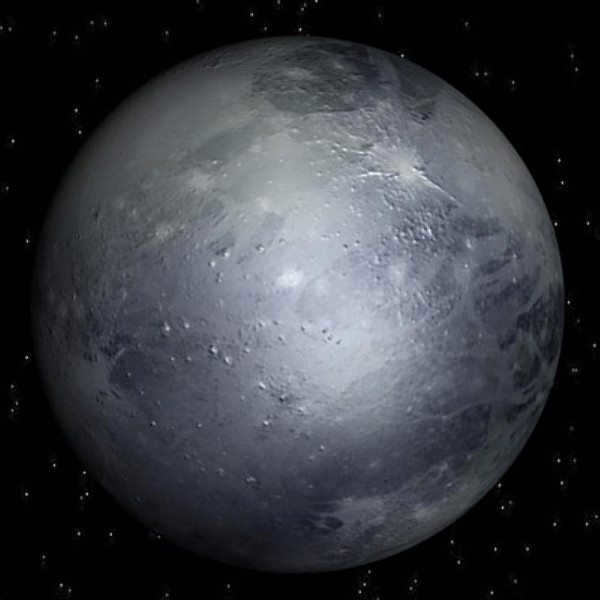
In 1978, scientists examined images of Pluto and made an interesting discovery. Upon closer inspection, they noticed a small protrusion in front of the planet’s disk.
Pluto-Charon
This particular system is named as such due to the shared characteristics of a satellite and a planet. One hypothesis suggests that both objects in the solar system formed simultaneously during a collision event, resulting in their independent formation. In other words, Charon is essentially a fragment of Pluto. Therefore, it is plausible to speculate that Nycta and Hadra are also remnants of the planet. The origins of these small satellites still remain a scientific enigma.
A fascinating occurrence
Between 1985 and 1990, Pluto and Charon experienced an extraordinary event known as an eclipse. During this period, it was possible to observe the orbits of both the satellite and the planet from the Earth’s surface. This phenomenon is incredibly rare and only happens twice within Pluto’s 248-year revolution around the Sun. Luckily, during the late 1980s, scientists were fully focused on studying Pluto, allowing them to accurately document the size of the satellite. Unfortunately, the next opportunity to witness and record such an event will not occur for quite some time.
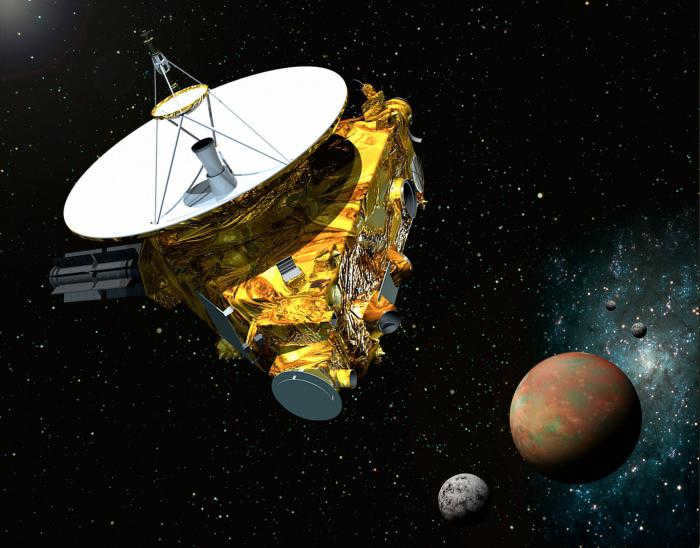
Distinctive Features of Charon
Because of its considerable distance from the star, Charon possesses an extremely frigid surface, with a temperature of minus 220 degrees. Unsurprisingly, the satellite is entirely blanketed by a thick layer of ice. This particular detail prompts even more inquiries and conjectures from scientists, including those pertaining to the genesis of the celestial body. One theory posits that the satellite experiences geological activity, which allows for the formation of water on its surface, despite the extremely low temperatures. This notion is supported by the discovery of ammonia hydrates on Charon’s surface, which would have had to undergo complete decomposition due to solar activity.
Predictions
Astronomers and other scientists have a keen interest in delving deeper into the matter of Pluto’s satellites and their origins, with a special focus on Charon. To this end, a series of studies dedicated to this planet and its satellites is scheduled to commence in 2015.
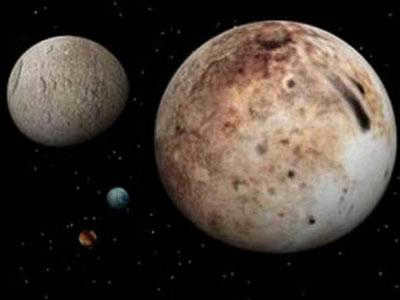

It is worth mentioning that Charon orbits in sync with Pluto, resulting in both always facing each other with the same side. These intriguing details have naturally captured the attention of the scientific community.
Pluto’s Small Satellites
Two smaller siblings of Charon, P1 “Hydra” and P2 “Nykta”, were discovered relatively recently in 2005. They have a diameter of only 45-55 km.
In 2011, the fourth satellite of Pluto, P4, was found. It has a diameter of 13-33 km. Then, in 2012, another newly discovered satellite, P5, joined the “satellite family”. Its diameter is only 10-25 km. As you can see, the small satellites of Pluto, which are continuously being added to the list, have not yet been named. However, there is already information that P4 and P5 will be given the nicknames Vulcan and Cerberus, respectively. These names received the most votes in an internet poll conducted by the SETI Institute.
To sum up
In 2013, there were 5 known celestial bodies orbiting Pluto, although it is believed that there may be many more smaller bodies that have yet to be discovered. It is possible that additional fragments broke off during the formation of the planet, so there may be more satellites waiting to be found in the future.
The names of Pluto’s satellites are still being confirmed, and they, along with the mysterious Charon, will continue to be studied. There are intriguing hypotheses and conjectures surrounding these satellites, but they have not yet been backed up by solid evidence or facts.
Thanks to the advancements in technology and the availability of high-quality images, experts now have the ability to not only characterize satellites, but also simulate the process of their formation. This not only provides answers to many questions, but also presents a plethora of new and intriguing mysteries for humanity, who are eager to explore the vastness of the Universe.
Within our solar system, there are planets that are classified as dwarfs due to their small size. One such planet is Pluto, which also has its own set of satellites. The largest of these satellites is known as Charon, but it is not the only one of its kind. There are other satellites as well, although they may not be as sizable, they still hold great significance.
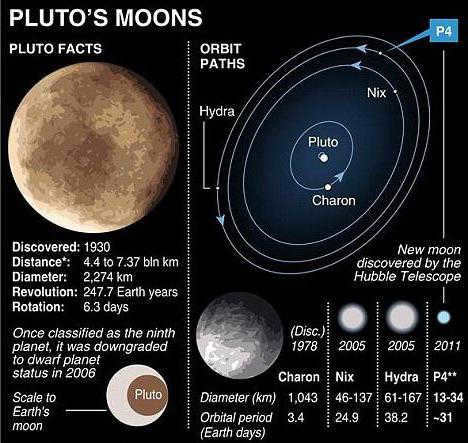
In this article, we will explore the characteristics of Pluto and delve into the nature of Charon, a satellite orbiting this celestial body. Additionally, we will discuss the various smaller satellites that accompany it.
The Enigmatic Pluto
Up until 2006, Pluto held its place among the primary planets of our solar system, considered an equal member of the planetary roster.
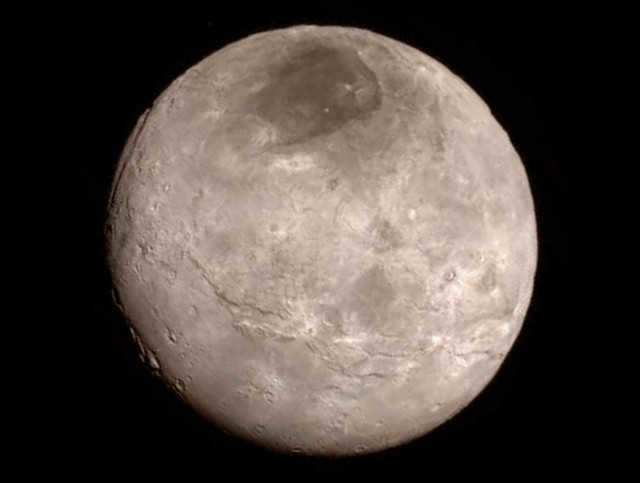
Pluto has now been designated as a dwarf planet, and it is considered to be the most sizable entity within the circular, shadowy region.
Once scientists realized that Pluto is not the only object in its vicinity, which includes all the other planets in the solar system, and that there may be more objects to be discovered beyond Neptune’s orbit, a new body named Erida was soon found. This trans-Neptunian object could be compared to Pluto. This discovery led to the realization that there was no clear definition of a planet. In 2006, a definition was adopted that includes three criteria. According to this definition, objects that meet only two of the three criteria are classified as dwarf planets. Pluto is one of these dwarf planets.
The distant, probably cold and dark planet was named after the god of the underworld by an eleven-year-old girl who shared her idea with her grandfather. The grandfather then passed on the girl’s wish to the observatory, where it was ultimately approved.
In January 2006, a spacecraft called New Horizons was launched towards Pluto. This device flew to the planet at a distance of twelve thousand kilometers and collected a wealth of information about it. The transmission of this data to scientists is a gradual process due to the slow speed of information transfer over such great distances.
Pluto, much to everyone’s astonishment, was found to have a perfectly spherical shape. Equally surprising was the revelation of numerous distinct landforms scattered across its surface.
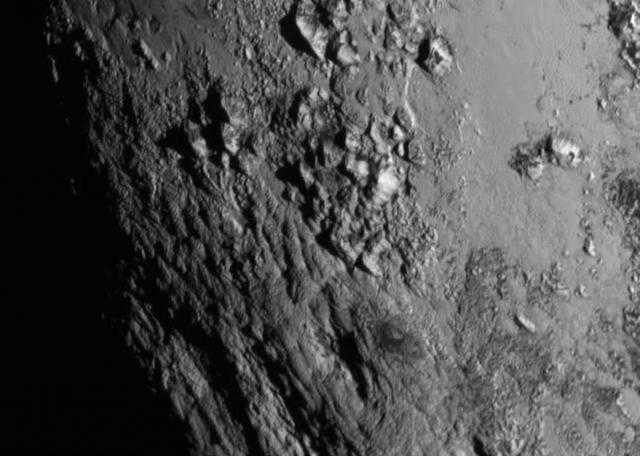
In addition, the planet has vast regions that lack any impact craters. Furthermore, the distribution of glaciers on Pluto’s surface is uneven, but the reason for this remains unclear.
Due to their considerable distance from Earth, both Pluto and its satellite Charon, along with the other small satellites, have not been extensively studied. There is a hypothesis that the planet’s surface consists of a rocky base covered with water ice, as well as frozen methane and nitrogen. The red color of the planet is believed to be caused by the byproducts of methane photodissociation.
As it revolves around its elliptical orbit, Pluto experiences extreme variations in its proximity to the Sun. During its close approach, the heat causes the glaciers to melt, resulting in the formation of an atmosphere composed of methane and nitrogen. However, as the planet moves farther away from the Sun, the atmosphere gradually diminishes, eventually transforming into a faint haze with a reddish hue. This change is attributed to the re-freezing of the glaciers.
Pluto’s Moons: Charon and the Minor Satellites
Pluto has a total of five natural moons. The biggest moon, Charon, was first observed in 1978. Two smaller moons, named Nycta and Hydra, were discovered in 2005.
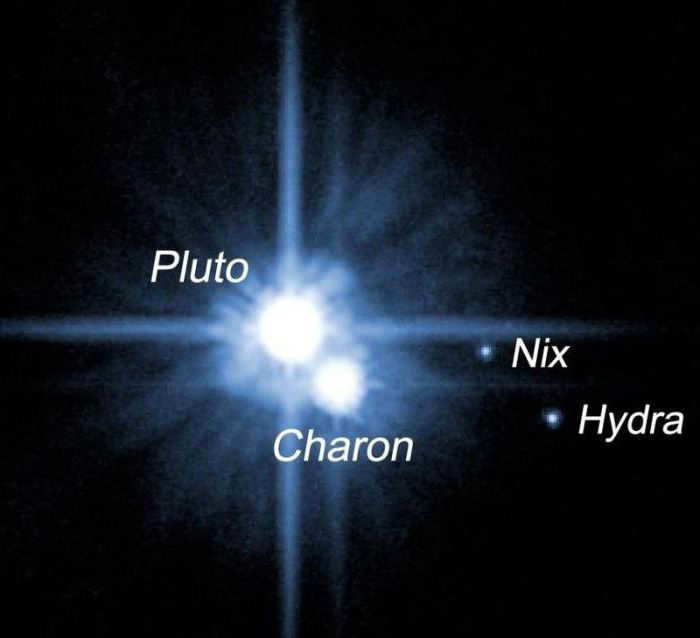
The next satellite to be discovered was Kerber, thanks to the Hubble telescope in 2011. Then in 2012, scientists made another discovery – Pluto’s fifth satellite, which they named Styx. All the names of these satellites are somehow related to the underworld in Greek mythology.
Charon: Pluto’s Largest Moon
Charon was named after the ferryman of the dead from ancient Greek mythology. It was first observed by American astrophysicist James Christie at the Naval Observatory in 1978.
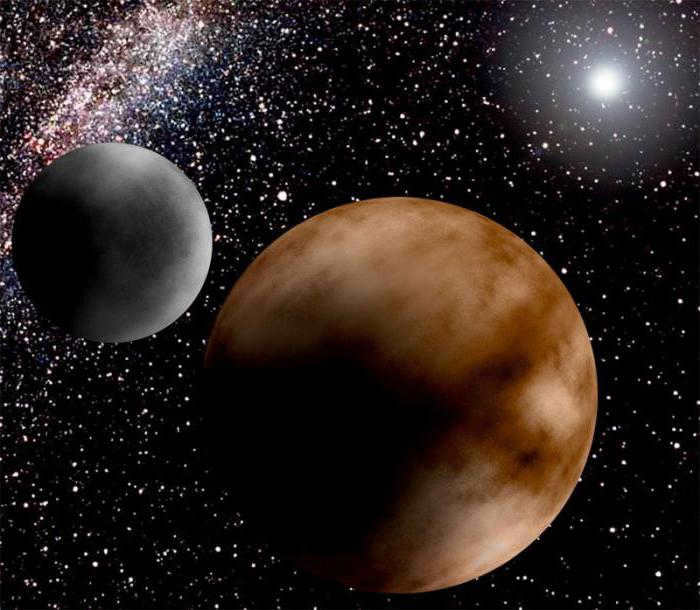
This celestial body is of considerable size, measuring approximately half the diameter of Pluto itself. The satellite orbits at a distance of nearly twenty thousand kilometers from the planet it accompanies, which is roughly equivalent to the distance between London and Sydney.
Charon, as it is known, is a satellite of Pluto that some scientists now regard as a minor component of a binary system of celestial bodies. In fact, it was even designated as Pluto 1. Notably, both Pluto and Charon share the same rotational period, resulting in a phenomenon known as tidal lock, where they constantly face each other with the same side.
The characteristics and makeup of the satellite
The satellite Charon possesses a distinct composition in comparison to Pluto. Unlike the planet, Charon is not covered in nitrogen ice but instead is adorned with a layer of water ice. This stark difference can be attributed to its incredibly low surface temperature of -220 degrees Celsius. Moreover, the composition of Charon is influenced by its lack of sufficient mass to retain volatile compounds. In terms of color, the satellite has a more neutral and grayish appearance. According to prevailing theories, Charon was formed from fragments that orbited around Pluto itself. Additionally, many scientists propose a correlation between the atmospheres of Pluto and Charon.
Nycta satellite
Nycta, which is one of Pluto’s satellites, was officially announced to the public on October 31, 2005. It was given its name in honor of the goddess associated with eternal darkness.
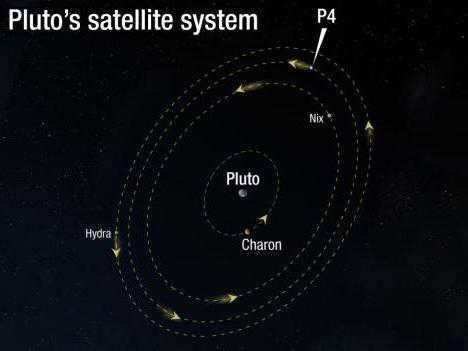
The satellite is located in a circular orbit. The exact dimensions of Nycta are not known, but it is believed to be smaller than Hydra based on its darker surface color.
Hydra
Upon closer inspection of existing images, it is apparent that Hydra lies in the same orbital plane as the satellite Charon. The distance between Pluto and Hydra is about 65,000 kilometers. There is no precise data regarding the size of this satellite, but scientists speculate that its diameter falls within the range of 52 to 160 kilometers.
Hydra’s surface is brighter than Nycta’s by approximately 25%. This indicates a higher reflectivity and suggests a larger size. The satellite was named after a mythological creature with a hundred heads in Greek mythology.
Kerber and Styx
Kerber, the fourth moon of Pluto, was named after a mythical character from the underworld. At the time of its discovery, it was believed to be the smallest moon of Pluto until the fifth moon was found. Scientists estimate that Kerber has a diameter ranging from 13 to 34 kilometers.
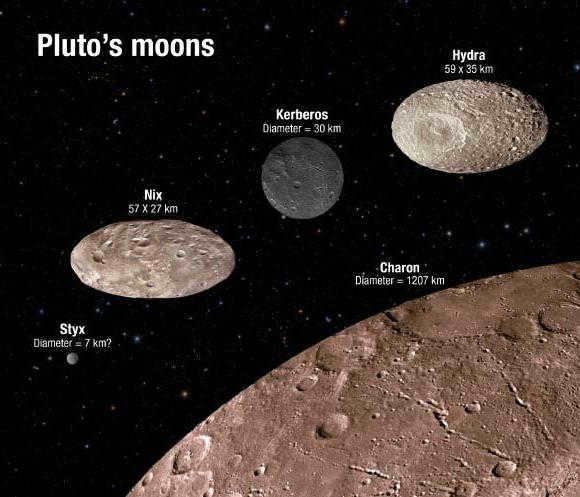
The Hubble Space Telescope was instrumental in the identification of Kerber. The orbit of this fourth satellite is positioned between Nykta and Hydra. It completes a full rotation around the planet in a period of thirty-one days.
Styx, the fifth satellite, is the smallest in size, with an estimated diameter ranging from 10 to 25 kilometers. It orbits between Charon and Nycta. Its resonance with Charon is in a one-to-three ratio. The satellite derives its name from the river in ancient Greek mythology that separates the realm of the living from the realm of the dead. Its discovery was also facilitated by the Hubble Telescope in June 2012.
In this article, we have covered a number of queries. We have explored the identity of Charon, a satellite of a particular planet, as well as its unique attributes, size, and composition. So, when someone asks, “Which planet does Charon orbit?” you can confidently respond, “Pluto.” Interestingly, one theory regarding the origin of Pluto’s satellites suggests that they were formed due to a collision between this planet and a large object from the Kuiper belt. Unfortunately, our knowledge about these intriguing bodies remains limited. After all, Pluto is not only situated at a great distance from Earth but also lacks a high degree of reflectivity.
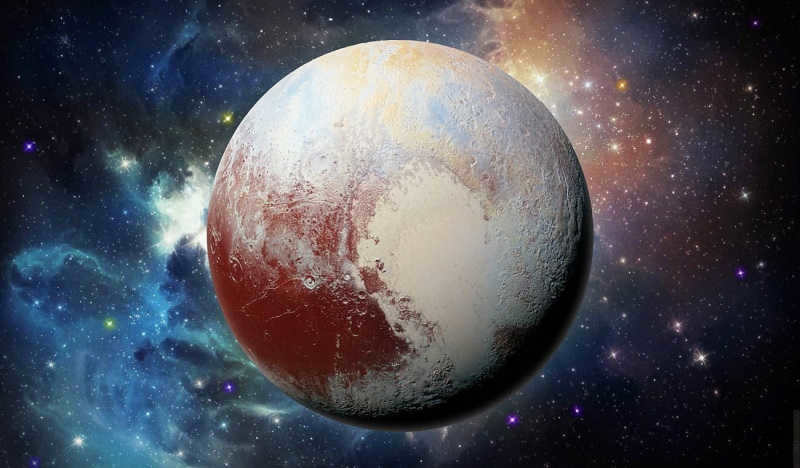
Pluto holds the distinction of being the most sizable dwarf planet known to mankind within our solar system. Originally, it was classified as the ninth classical planet, but its status changed in 2006 to that of a dwarf planet, making it the largest object located in the Kuiper belt. It is worth noting that the element plutonium received its name from Pluto.
The origins of Pluto and its position in the categorization of celestial bodies within the solar system have remained a puzzle for quite some time. Back in 1936, Raymond Littleton, an astronomer from England, put forth the hypothesis that Pluto may have been a “runaway” satellite of Neptune, knocked off its orbit due to the influence of Neptune’s largest satellite, Triton. However, this theory has faced strong criticism as Pluto never approaches Neptune in its orbit.
In 1992, astronomers made a series of discoveries regarding small icy bodies beyond the orbit of Neptune. These bodies were similar to Pluto not only in terms of their orbit, but also their size and composition. This region of the outer solar system was subsequently named after Gerard Kuiper, an astronomer who proposed that it was the source of short-period comets.
As of July 2015, Pluto is the largest known object in the Kuiper belt. It shares many characteristics with other bodies in this region, including comets. The solar wind blows gases from Pluto’s atmosphere, similar to what happens with comets. If Pluto were located as close to the Sun as Earth, it would even develop a comet tail.
Triton, the companion of Neptune and slightly larger than Pluto, has a composition similar to Pluto (although its geologic characteristics are very different) and is likely to have been captured from the same belt. Erida, which is only slightly smaller than Pluto, is not considered a belt object but is probably part of a scattered disk. There are a significant number of belt objects, like Pluto, that have a 3:2 orbital resonance with Neptune and are known as “plutinos.”
In May 1930, the International Astronomical Union classified Pluto as a planet (at that time, it was believed to be similar in size to Earth). However, since the discovery of the first Kuiper Belt object, 1992 QB1 (also known as 15760), in 1992, this classification has been questioned. The discovery of other bodies in the Kuiper Belt has only added to the controversy. Eventually, on August 24, 2006, Pluto was reclassified as a dwarf planet.
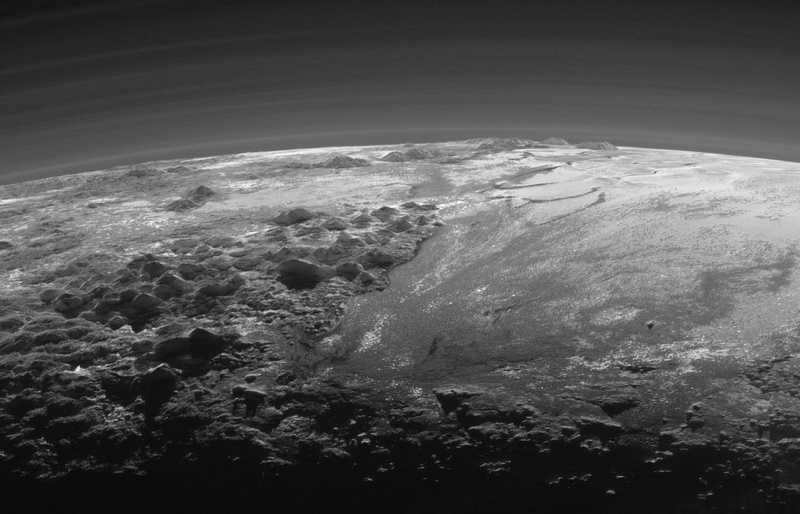
Similar to other celestial bodies in the Kuiper Belt, Pluto is primarily made up of a combination of rock and ice and is comparatively small in size: its mass is approximately six times less than that of the Moon and its volume is around three times less. The surface area of Pluto (17.7 million km²) is slightly greater than that of Russia (17.1 million km²). In addition, Pluto’s orbit displays a significant eccentricity and inclination in relation to the ecliptic plane.
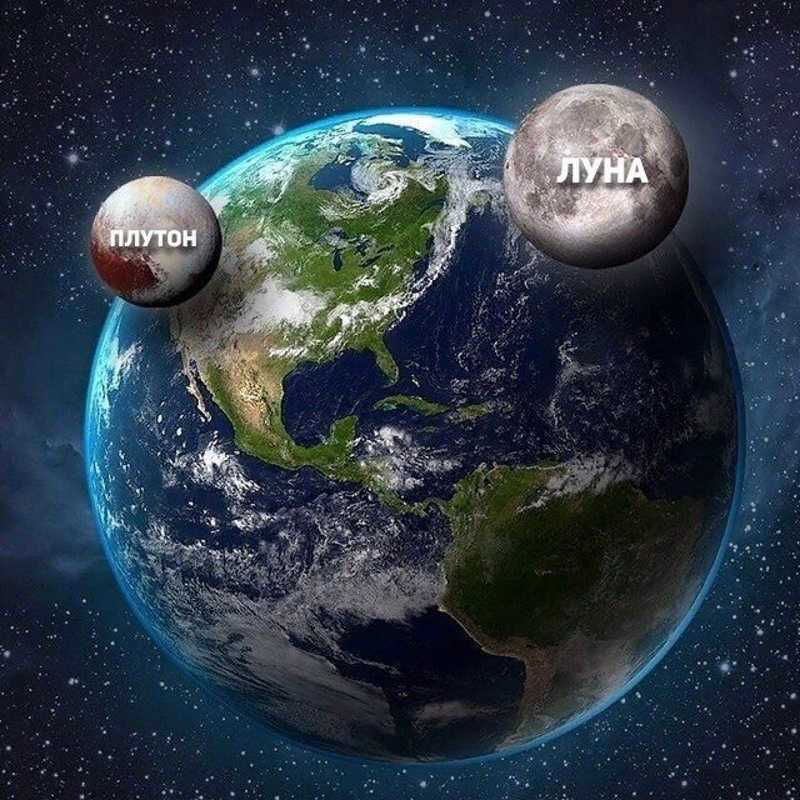
Due to the elliptical nature of Pluto’s orbit, it comes closer to the Sun at a distance of 29.7 a.u. (4.4 billion km), surpassing Neptune’s proximity, before moving further away at 49.3 a.u. (7.4 billion km). Pluto and its largest moon Charon, which was discovered in 1978, are often referred to as a binary system because the center of mass of their system lies outside of both objects.
Similar to Venus and Uranus, Pluto rotates in the opposite direction to the other planets around the Sun. A day on Pluto lasts 6.387 Earth days.
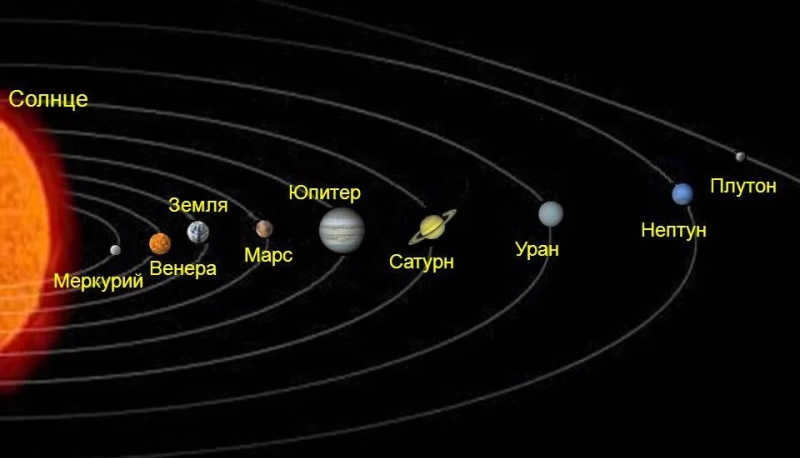
Pluto has a highly varied surface, which causes periodic fluctuations in its rotation and characteristics of light and spectrum. These variations have allowed scientists to discover that the side of Pluto facing away from Charon (180° E, where Pluto’s “heart” is located) has higher levels of nitrogen and carbon monoxide, while methane is most prevalent near 300° E. Additionally, the brightness and spectrum of Pluto are more pronounced in the vicinity of the planet itself.
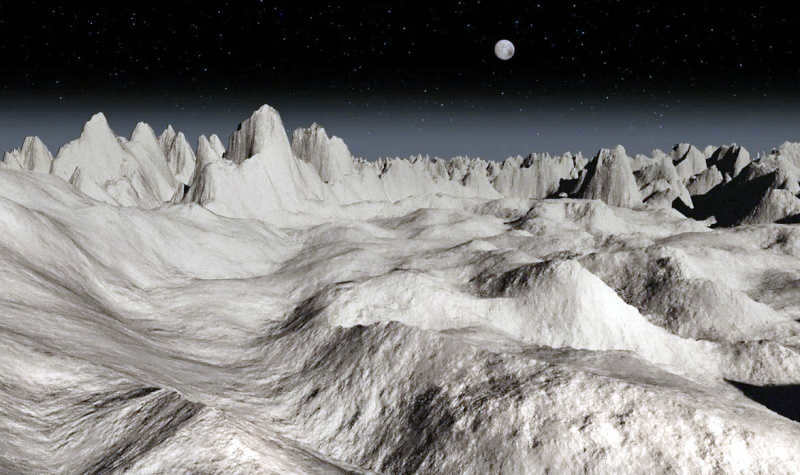

Spectral analysis has revealed the presence of water ice on the surface of Pluto. However, this water ice is mostly concealed by a layer of more easily evaporating ice, primarily nitrogen ice (97-98% composition). Additionally, frozen methane (1.5% or 3%, depending on the estimate) and carbon monoxide (0.01% or 0.5%) have been detected, along with trace amounts of other compounds resulting from the interaction of methane and nitrogen with intense radiation. These compounds include ethane, as well as potentially more complex hydrocarbons or nitriles, and tholins which contribute to Pluto’s brownish color, along with other distant celestial bodies. Notably, nitrogen, carbon monoxide, and to a lesser extent, methane, are highly volatile under the conditions on Pluto and can undergo seasonal movement across the planet’s surface.
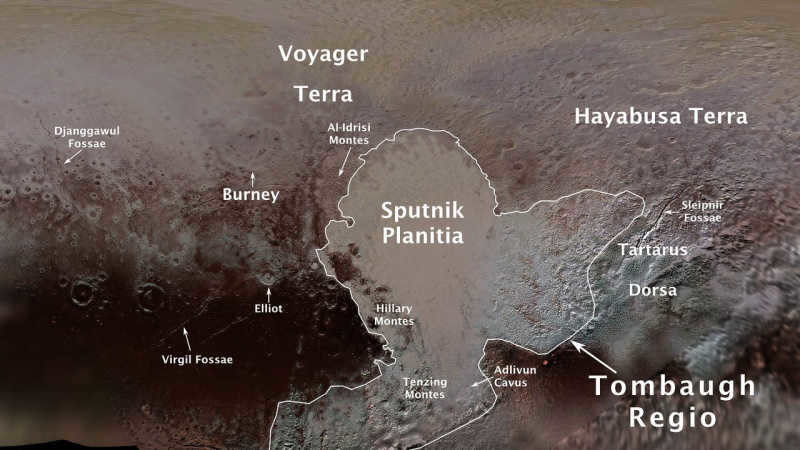
The International Astronomical Union approved six themes in February 2017 for naming the details of Pluto’s surface:
- gods, goddesses, and other beings associated with the underworld in mythology, folklore, and literature;
- names of the underworld and its places in mythology, folklore, and literature;
- heroes and other explorers of the underworld;
- scientists and engineers associated with Pluto and the Kuiper Belt;
- groundbreaking space missions and spacecraft;
- historical pioneers who reached new horizons in the exploration of the Earth, sea, and sky.
Pluto does not possess a significant magnetic field: its surface’s magnetic induction, based on its interaction with the solar wind, cannot exceed 30 nT, which is 2,000 times less than that of the Earth.
The atmosphere of Pluto is quite thin and is composed of gases that evaporate from the surface ice. These gases include nitrogen, methane (approximately 0.25%), and carbon monoxide (approximately 0.05-0.1%). Exposure to intense radiation leads to the formation of more complex compounds, such as ethane, ethylene, and acetylene, which then gradually settle on the surface. It is likely that these particles contribute to the creation of a light, layered haze that extends to altitudes exceeding 200 km.
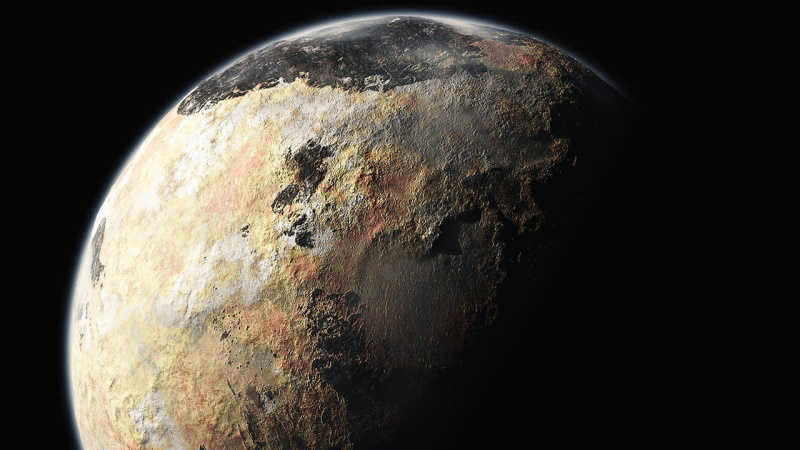
Pluto’s temperature on its surface rises as it goes higher (3-15 degrees per kilometer). The average temperature on the surface is 50 K (-223.15 °C), while the average temperature in the atmosphere is 40 degrees higher (according to 2008 data). This is due to the greenhouse effect caused by methane.
The interaction with the atmosphere has a significant impact on the temperature of Pluto’s surface. Calculations indicate that despite its very low pressure, the atmosphere is capable of effectively evening out the daily temperature fluctuations. Areas of the surface where nitrogen ice is evaporating are cooled (similar to the cooling effect during water evaporation) by up to 20 degrees.
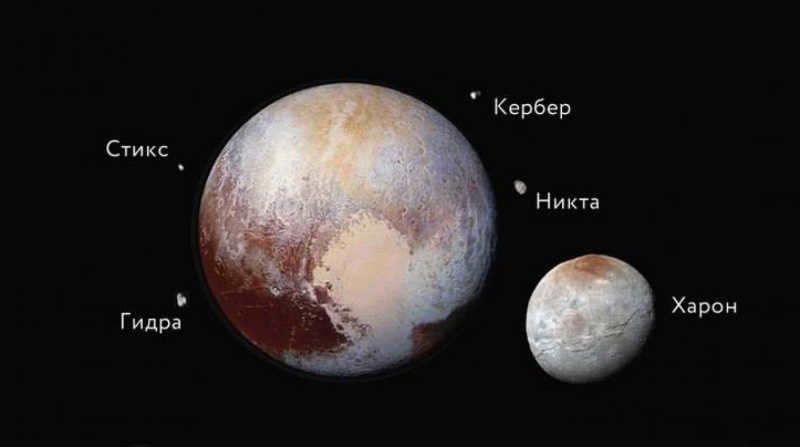
Pluto is home to a quintet of natural satellites:
These moons all follow nearly circular paths that align with Pluto’s equatorial plane and move in the same direction as Pluto’s rotation.
The first moon in proximity to Pluto is Charon, followed by Styx, Nycta, Kerberus, and Hydra. These moons are all in close orbital resonance, with their periods of revolution maintaining a ratio of approximately 1:3:4:5:6. Of these, Styx, Nycta, and Hydra are in a specific resonance with a period ratio of 18:22:33.
What makes Pluto’s satellite system intriguing is its minimal occupancy of available space. The maximum potential radius for stable orbits of prograde satellites is estimated to be 2.2 million km (even greater for retrograde satellites), yet the actual orbital radius of Pluto’s known satellites does not exceed 3% of this value (65,000 km).
Charon and Pluto rotate together, but the rest of the satellites have different rotation periods that are much shorter than their orbital periods. Additionally, their rotation axes are tilted compared to the axes of Pluto and Charon.
All four of Pluto’s small satellites have irregular shapes and surprisingly high brightness. Their geometric albedo is around 0.6, with Hydra even reaching 0.8. This is much higher than Charon’s albedo of 0.38 and most other small Kuiper belt objects, which have an albedo of about 0.1. It is likely that these satellites are covered in relatively pure water ice.
The discovery of Pluto’s small satellites initially suggested the presence of rings formed by meteorite impacts on these satellites. However, both the Hubble and New Horizons data have not shown any evidence of such rings. If they do exist, they are presumably very sparse, with a geometric albedo below 1.0×10-7.
Charon’s Identity
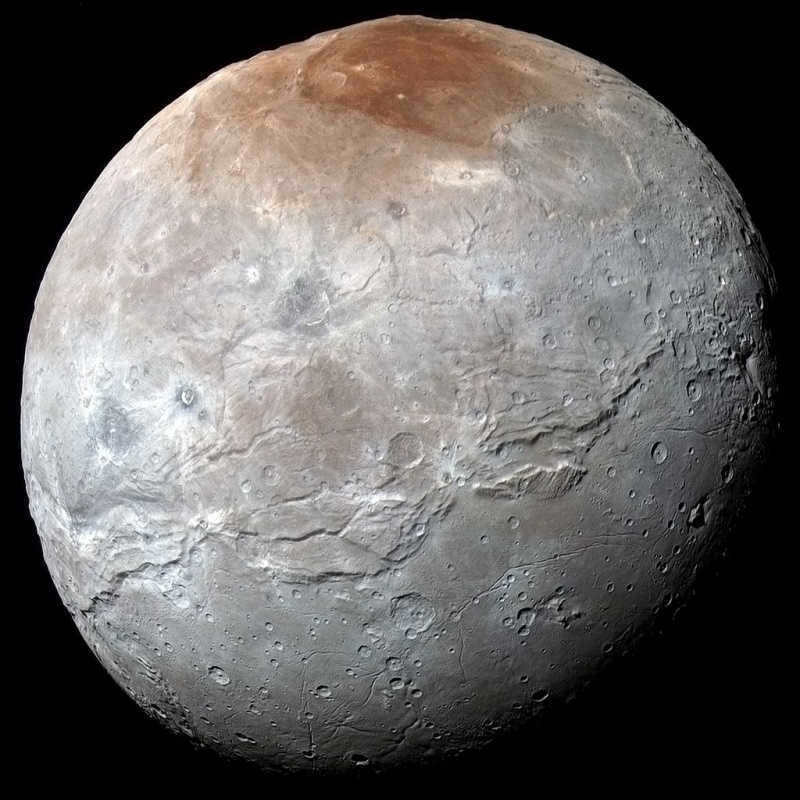

The International Astronomical Union announced on July 7, 1978, that James Christie had made the discovery of Pluto’s first satellite. Originally known as 1978 P 1, it was later given the name Charon, after the mythical ferryman who transported souls across the river Styx. Charon has a diameter of 1212 ± 6 km, which is slightly over half the diameter of Pluto, and a mass that is 1/8th that of Pluto. These proportions are quite significant, especially when compared to other celestial bodies. For example, the Moon’s mass is only 1/81st that of Earth, and the combined mass of all other planetary satellites is less than a thousandth of their respective planet’s mass. The distance between Pluto and Charon, specifically the major semi-axis of Charon’s orbit relative to Pluto’s center, measures 19,596 km.

As per the preliminary Resolution 5 of the XXVI General Assembly of the IAU (2006), Charon (alongside Ceres and Erida) was anticipated to receive the designation of a planet. The annotations to the draft resolution specified that if this were to happen, the Pluto-Charon system would be recognized as a binary planet. However, ultimately, a different verdict was reached: Pluto, Ceres, and Eridu were grouped under a new category of dwarf planets, while Charon was not even included among them due to its status as a satellite.
In June 2016, findings from a NASA research center’s investigation were published, suggesting the presence of significant graphite deposits concealing themselves on Charon’s surface.
Hydra and Nycta
The story of Hydra and Nycta is a fascinating one. These mythical creatures have captivated the imaginations of people for centuries.
Hydra, a multi-headed serpent, is known for its ability to regenerate heads when they are cut off. It is said that for every head that is cut off, two more grow in its place. This makes Hydra a formidable opponent and a symbol of resilience and endurance.
On the other hand, Nycta is a mysterious creature that comes out only at night. It is said to have the ability to control the shadows and move silently in the darkness. Nycta is often associated with fear and darkness, but it is also seen as a symbol of hidden strength and power.
The story of Hydra and Nycta is often used as a metaphor for overcoming challenges and embracing the unknown. It reminds us that even in the face of adversity, we have the ability to adapt and grow. Just like Hydra’s heads, we can regenerate and become even stronger.
So let the story of Hydra and Nycta inspire you to face your fears and embrace the unknown. Remember that you have the power to overcome any challenge that comes your way.
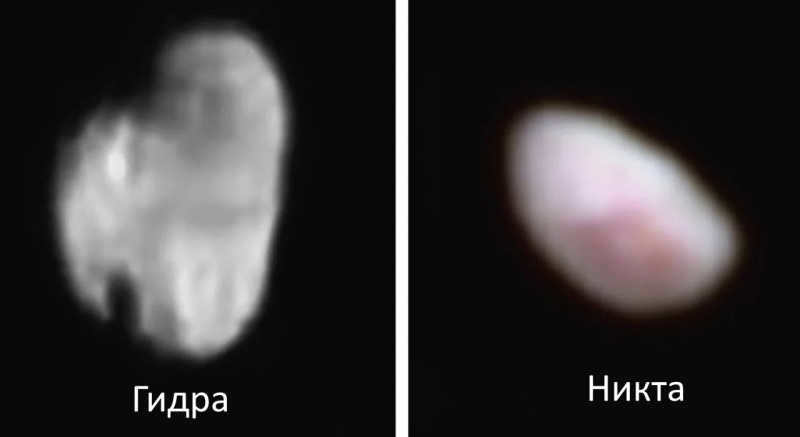
The Hubble Space Telescope captured images of these two satellites on May 15 and 18, 2005, leading to their discovery. The announcement of their discovery was made on October 31, 2005. Initially, they were referred to as S/2005 P 1 and S/2005 P 2, but on June 21, 2006, the International Astronomical Union officially named them Hydra (also known as Pluto III, the more distant satellite) and Nycta (Pluto II, the closer one) respectively. Their orbits are significantly farther than Charon, with Nycta having an orbital radius of 49,000 km and Hydra with 65,000 km. These two satellites are in orbital resonance, with Hydra completing two revolutions for every three of Nycta’s.
Hydra’s dimensions are 43×33 km, and Nykta’s dimensions are 54×41×36 km. The exact masses of these moons are uncertain, but it is estimated that they are approximately 0.003% of Charon’s mass (equivalent to 0.0003% of Pluto’s mass) each. Both moons display visible craters on their surfaces. In addition to variations in brightness, Nykta also exhibits differences in color, with a dark reddish area surrounding a prominent crater.
Kerber and Styx
The musical collaboration between Kerber and Styx is an incredible fusion of talent and creativity. These two iconic bands have joined forces to create a unique and unforgettable experience for fans around the world. The synergy between their distinct styles and sounds is truly remarkable, resulting in a harmonious blend of rock and pop elements that captivates audiences from start to finish. Kerber’s powerful vocals and Styx’s intricate instrumentals complement each other perfectly, elevating their music to new heights. Whether you’re a longtime fan or new to their music, the collaboration between Kerber and Styx is sure to leave a lasting impression.
